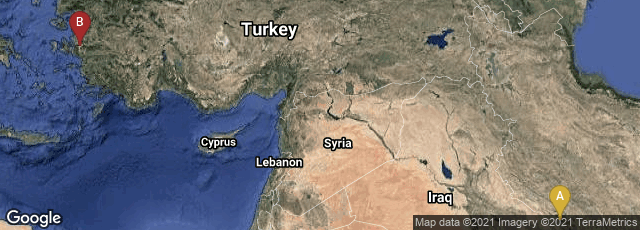
A: Shush, Khuzestan Province, Iran, B: İzmir, Turkey
By the time of Herodotus (circa 484-425 BCE) the Persian Royal Road ran some 2,857 km from the city of Susa on the lower Tigris to the port of Smyrna (modern Izmir in Turkey) on the Aegean Sea. A highway built by the Persian King of Kings Darius I to facilitate rapid communication and intelligence gathering throughout the Persian Empire, the Royal Road was protected by Persian rulers and later used by the Romans. On this road couriers, riding in relays, could travel 1,677 miles (2,699 km) in seven or nine days.
Herodotus wrote:
“There is nothing that travels faster, and yet is mortal, than these couriers; the Persians invented this system, which works as follows. It is said that there are as many horses and men posted at intervals as there are days required for the entire journey, so that one horse and one man are assigned to each day. And neither snow nor rain nor heat nor dark of night keeps them from completing their appointed course as swiftly as possible. The first courier passes on the instructions to the second, the second to the third, and from there they are transmitted from one to another all the way through, just as the torchbearing relay is celebrated by the Hellenes in honor of Hephaistos. The Persians call this horse-posting system the angareion" (Strassler [ed] The Landmark Herodotus: The Histories [2007] 8.98, p. 642).
By having fresh horses and riders ready at each relay, royal couriers may have carried messages the entire distance in 7 to 9 days, though normal travelers, or an army on foot, might have taken about three months. This Royal Road linked into many other routes in the overall trade network known as the Silk Road. Some of these roads, such as the routes to India and Central Asia, were also protected, encouraging regular contact between India, Mesopotamia and the Mediterranean. There are accounts in the Old Testament Book of Esther of dispatches being sent from Susa to provinces as far out as India and Cush (Kush) during the reign of Xerxes (485-465 BCE).
"The postal system during the reign of Xerxes I is also described in the Biblical Book of Esther. While the historical details of the Book of Esther are difficult to verify, it would appear that a swift messenger system connecting all provinces of the Persian Empire was at the disposal of the ruler. In this case, the system was used not to gather information about provincial affairs but to send royal decrees throughout the realm. Thus, when Hāmān secured the King’s permission to kill the Jews of the empire, ‘Letters were sent by courier to all the King’s provinces with orders to destroy, slay and exterminate all Jews’ (Esther 3: 13). When, through the efforts of Mordecai and Esther, the King agreed to spare the Jews, ‘Letters were sent by mounted couriers riding on horses from the royal stable. By these letters the King granted permission to the Jews in every city to unite and defend themselves …’ (8: 10); thus ‘the couriers, mounted on their royal horses, were despatched post-haste at the King’s urgent command; and the decree was issued also in Susa the capital’ (8: 14).
"In this case, the Achaemenid postal system was employed to circulate royal decrees throughout the provinces of the empire, using riders ‘on horses from the royal stable’. The English translation of these verses is deceptively readable and cannot be seen as loyal to the complexities of the original Hebrew text. For instance, the term aḥashtranīm (Esther 8: 10, 14) used to describe the royal mounts has conveniently been ignored in the English version. In fact, this word is a hapax legomenon and has generated exegetical controversy" (Silverstein, Postal Systems in the Pre-Islamic World [2007] http://www.cambridge.org/us/catalogue/catalogue.asp?isbn=9780521858687&ss=exc, accessed 01-14-2010).
Until the development of effective optical telegraph systems at the end of the 18th century, messengers on horseback, riding over a good road system, remained the fastest method of sending a message overland.